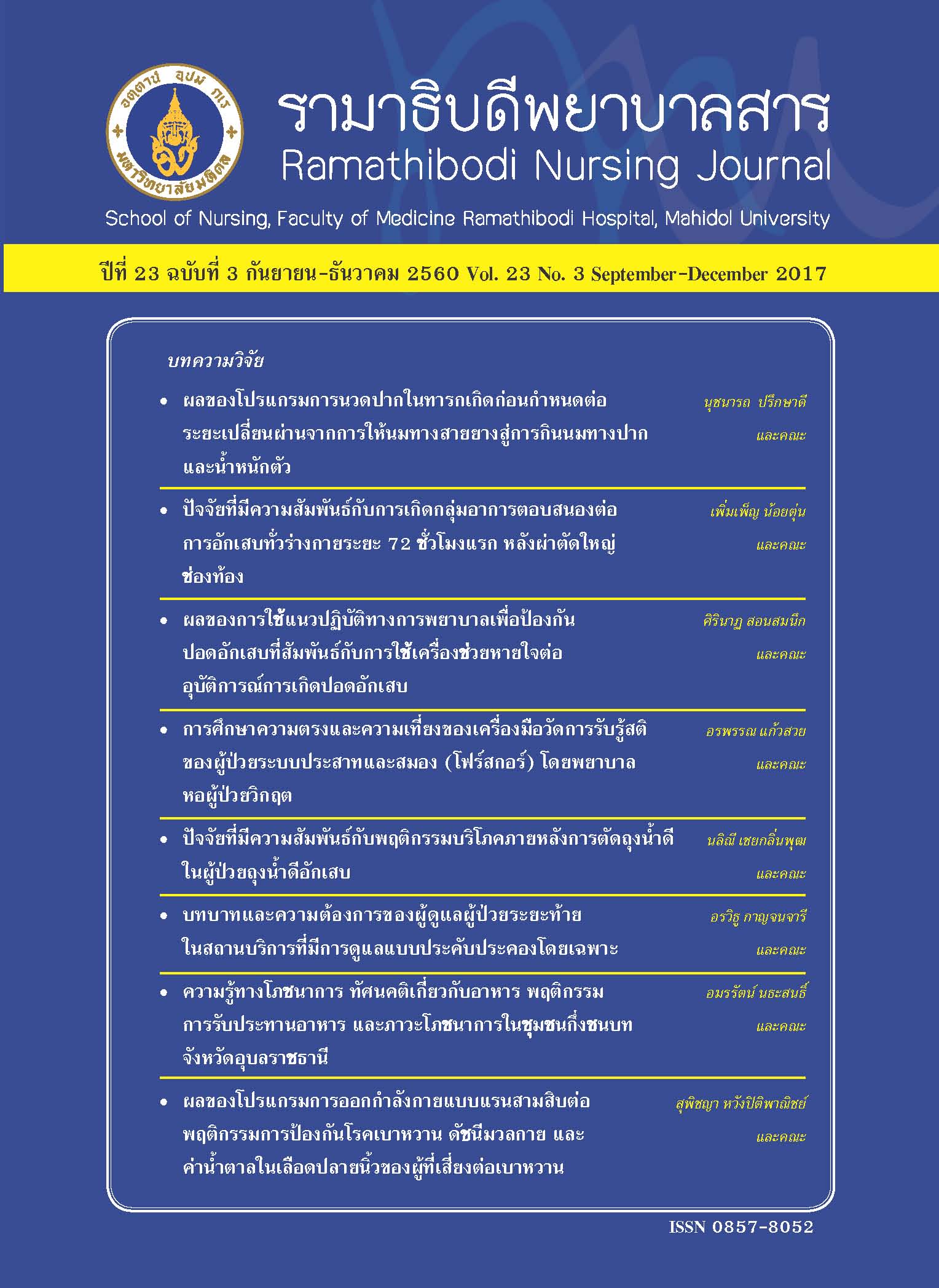The Study of Validity and Reliability of the the FOUR Score in Critical Care Nurses
Main Article Content
Abstract
การศึกษานี้มีวัตถุประสงค์เพื่อศึกษาคุณภาพของเครื่องมือที่ใช้ประเมินระดับการรับรู้สติของผู้ป่วยโรคระบบประสาทและสมอง กลุ่มตัวอย่างที่ใช้ศึกษา คือพยาบาลหอผู้ป่วยวิกฤตศัลยกรรมที่มีอายุงาน 2 ปีขึ้นไปจำนวน 26 คน และผู้ป่วยโรคระบบประสาทและสมองที่เข้ารับการรักษาที่หอผู้ป่วยวิกฤตศัลยกรรม จำนวน 66 คน วิธีดำเนินการวิจัย แพทย์ผู้เชี่ยวชาญประเมินผู้ป่วยด้วย GCS และ FOUR score จากนั้นให้พยาบาลประเมิน GCS และ FOUR score ในผู้ป่วยรายเดียวกันโดยระยะเวลาห่างกันไม่เกิน 30 นาที ผลการศึกษาพบว่า การใช้แบบประเมินการรับรู้สติ FOUR score เพื่อประเมินการรับรู้สติในผู้ป่วยโรคระบบประสาทและสมองเปรียบเทียบกับแบบประเมิน GCS มีความตรงตามเกณฑ์สัมพันธ์ (criterion related validity)ในระดับสูง (r = .97, p < .01) นอกจากนี้ การประเมินการรับรู้สติด้วยแบบประเมิน FOUR score เปรียบเทียบกับแบบประเมิน GCS ในผู้ป่วยโรคระบบประสาทและสมองที่มีการรับรู้สติแตกต่างกัน พบว่า ระดับการรับรู้สติที่ดี ภาวะง่วงซึม ภาวะมึนงง และ หมดสติ มีความตรงตามเกณฑ์ (criterion related validity)ในระดับปานกลางถึงดีมาก (r = .91, .70, .69, 1.00, p < .01) ตามลำดับ สำหรับ พบว่า ความสอดคล้อง หรือความเที่ยง (inter-rater reliability) ของการใช้แบบประเมินการรับรู้สติ FOUR score และ GCS ระหว่างแพทย์ผู้เชี่ยวชาญและพยาบาลวิกฤตศัลยกรรมที่อายุงานมากกว่า 5 ปี และ 2-5 ปี พบว่ามีระดับดีมาก (k = 1.00) และ ดี (k = .80) ตามลำดับ การวิเคราะห์รายด้านของแบบประเมิน FOUR score พบว่า การประเมินด้านการเคลื่อนไหวมีความสอดคล้องกันน้อยที่สุด (k = .97) และรายด้านของแบบประเมิน GCS พบว่า การประเมินด้านการพูดมีความสอดคล้องกันน้อยที่สุด (k = .93)
สรุป แบบประเมิน FOUR score มีความตรงและความเที่ยงในการประเมินการรับรู้สติ แต่ควรจะจัดอบรมก่อนนำไปใช้ โดยเฉพาะพยาบาลที่มีอายุงานน้อย
Article Details
บทความ ข้อมูล เนื้อหา รูปภาพ ฯลฯ ที่ได้รับการตีพิมพ์ในรามาธิบดีพยาบาลสาร ถือเป็นลิขสิทธิ์ของวารสาร หากบุคคลหรือหน่วยงานใดต้องการนำทั้งหมดหรือส่วนหนึ่งส่วนใดไปเผยแพร่หรือเพื่อกระทำการใด ใด จะต้องได้รับอนุญาตเป็นลายลักษณ์อักษรจากรามาธิบดีพยาบาลสารก่อนเท่านั้น
References
2. Kusum V. Critical carenursing: a holistic approach, 4thed. Bangkok: Sahaprachapanich; 2010. (in Thai)
3. Cohen J. Interrater reliability and predictive validity of the FOUR score coma scale in a pediatric population. J Neurosci nurs 2009;41:261–7.
4. Wijdicks EF, William RB, Boby VM, Edward MM, Robyn LM. Validation of a new coma scale: the FOUR Score. Annals of Neurology. 2005;58:585-93.
5. Stead LG, Wijdicks EF, Bhagra A, Kashyap R, Nash DL, Enduri S, et al. Validation of a new coma scale, the FOUR Score, in the emergency department. Neurocrit Care. 2009;10:50-4.
6. Jennett B. The Glasgow Coma Scale: history and current practice. Trauma. 2002,4:91–103.
7. Shoqirat N. Nursing students’ understanding of the Glasgow coma scale. Nurs Stand. 2006;20:41-7.
8. Teasdale G, Jennett B. Assessment of coma and impaired consciousness. The lancet. July 1974;13:81–3.
9. Teasdale G, Jennett B. Assessment and prognosis of coma after head injury. Acta Neurochir (Wien). 1976;34:45-55.
10. Georgios M, Theodossios B. The Glasgow Coma Scale – a brief review past present future. Acta Neurol. 2008;108: 75–89.
11. Silvitasari I, Purnomo HD, Sujianto U. Sensitivity and specificity of Full Outline of Unresponsiveness Score and Glasgow Coma Scale towards patient’s outcomes at the intensive care units. JOSR-JNHS. 2017;6(1):10-3.
12. Iyek VN, Mandrekar JN, Danielson RD, Zubkov AY, Elmer JL, Wijdicks EF. Validity of the FOUR Score coma scale in the medical intensive care unit. Mayo Clin Proc. 2009; 84(8):694-701.
13. Chen B, Grothe C, Schaller K. Validation of a new neurological score (FOUR Score) in the assessment of neurosurgical patients with severely impaired consciousness. Acta Neurochir. 2013;155:2133–9.
14. Juan P, Yingying D, Fangyao C, Xiaomei Z, Ying Z, Hongzhen Z, et.al. Validation of the Chinese version of the FOUR score in the assessment of neurosurgical patients with different level of consciousness. BMC Neurology. 2015;15:254-60.
15. Weiss N, Mutlu G, Essardy F, Nacabal C, Sauves C, Bally C, et al. The French version of the FOUR score: a new coma score. Revue Neurol (Paris). 2009;65:796-802.
16. Wolf CA, Wijdicks EF, Bamlet WR, Mccleland RL. Further Validation of the FOUR Score coma scale by intensive care nurses. Mayo Clinic Proceedings. 2007; 82:435-8.
17. Metheesiriwat N, Kuptniratsaikul S. The FOUR score and Glasgow coma scale to evaluate the patiens with intubation at emergency room. Royal Thai Army Medical Journal. 2012;65:145-52. (in Thai)
18. Srisatidnarakul B. The methodology in nursing research. 4thed. Bangkok: You and I Intermedia; 2005. (in Thai)
19. Naipat A. Quantitative and qualitative research methodologies in behavioral and social science. Bangkok: Srinakarinwirot University; 2005. (in Thai)
20. Anita MS, Ramesh T, Sandhya Y, Hemant. Can FOUR Score replace GCS for assessing neurological status of critically ill patients - an indian study. Nursing and Midwifery Research Journal. 2013;9:63-72.
21. Royal College of Surgeons in Ireland; 2016 [cited 2016 June 08] Ronan MC, The RCSI sample size handbook Available from: http://rcsi.ie/files/research/docs/ 201608 11111051_Sample%20size%202016.pdf
22. Ruth S. FOUR Score challenges Glasgow Coma Scale. Emergency Medicine News. 2006;28(8):50-1.
23. Fischer J, Mathieson C. The history of the Glasgow Coma Scale: implications for practice. Crit Care Nurs Q. 2001; 23:52-8.
24. Deeying S, Kanogsunthornrat N. Quarity of (FOUR) Score: a literature review. [thesis]. Nakhon Pathom: Mahidol University; 2014. (in Thai)


